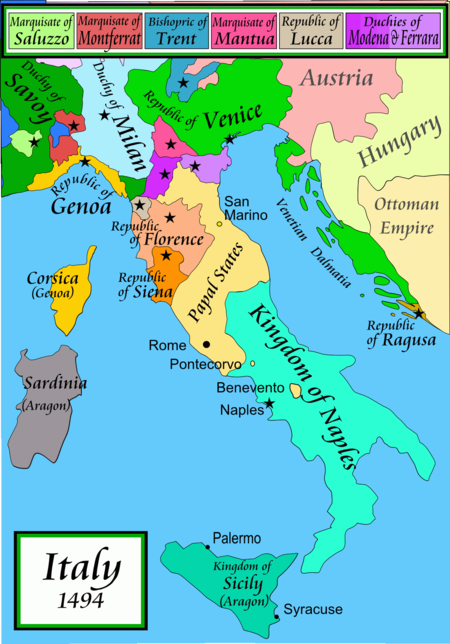The Italian Wars 1494-1559
Homework Help & Tutoring
We offer an array of different online The Italian Wars 1494-1559 tutors, all of whom are advanced in their fields and highly qualified to instruct you.
The Italian Wars 1494-1559
The invasion of Italy in 1494 by Charles VIII of France was facilitated, if not solely precipitated, by hostilities arising between the ruling families of Milan, Florence, Naples and Rome.

(Image courtesy of Wikipedia.org)
In the republic of Florence, the death of of Lorenzo de Medici in 1492 left his son, Piero as head of state, and political entanglements between Florence, Milan and Naples rapidly developed. Lorenzo had succeeded in maintaining conciliatory terms between both Milan and Naples through the Peace of Lodi, but relations deteriorated when Piero eschewed Milan and courted the good opinion of King Ferrante of Naples, urged on by his wife, whose Orsini relatives held much influence at the Neapolitan court. King Ferrante’s granddaughter, Isabella d’Aragon, was married to Gian Galeazzo, hereditary duke of Milan who had been usurped by his uncle, Ludovico Sforza. At Isabella’s request, King Ferrante sought to topple the usurper. In retaliation, and under fear of a possible coalition between Naples and Florence (which would one way or another draw in Venice) against the Milanese territories, Ludovico appealed to Charles VIII of France and offered the French army free passage through Milan.
Charles VIII had a claim to the Neapolitan lands which had been held by his ancestors until 1442, when the royal house of Aragon had seized sovereignty. The throne of Naples had been contested by Angevin and Aragonese houses since the thirteenth century, but on the death of René of Anjou in 1480, Charles had acquired a direct claim.
In 1494, Cardinal Rodrigo Borgia, of Spanish descent and receiving support from Aragon, was elected Pope Alexander VI. The pope continued his papal blessing of Ferrante’s sovereignty whilst simultaneously trying to maintain the peace with Charles. King Ferrante sought the pope’s assistance in ridding Milan of its usurping duke, offering in return, the hand of his granddaughter, Princess Sancia, in marriage to the pope’s youngest son, Jofre Borgia.
When King Ferrante died in January 1494, forcing Pope Alexander into making a decision to recognise the legal accession of Ferrante’s son, Alfonso, or abandon his link with the Aragon royals, it seemed inevitable that the pope would choose the former, making the French invasion an inevitability. When Juan Borgia-Lanzol, Cardinal of Moreale, in his role of Papal Legate, was sent to Naples to crown Alfonso, Charles VIII publicly declared war on the new monarch.
Thus the papacy was deeply committed to Aragon, and Florence, realising the gravity of the French threat, lent its support to the pope. When Milan effectively created an open door to Italy, panic reigned throughout the peninsula. Venice, believing the battle already lost, declared neutrality.
The city state was non-military and the Romagna barons recognised their weakness, as did Alexander. Nevertheless, he declared that Charles would not find access to Naples via the church states, and ordered defences prepared. In the meantime, Charles was raising money for his army in France, and signed peace treaties with England, the Holy Roman Empire, and Aragon (where King Ferdinand nevertheless supported Naples).
In September 1494, King Charles headed his vast and powerful army, spearheaded by the renowned German and Swiss mercenaries, through the Alps. New reached them that the Neapolitan navy had suffered defeat off Genoa by Louis d’Orleans, cousin of the French king.
Acting on his promise, Ludovico Sforza welcomed the French columns into Milan and Florentine resistance began to crumble. The city of Pisa claimed independence, thus effectively severing the republic’s economic lifeline. Piero de Medici threw himself on the mercy of Charles and the Medici palace was sacked by the Florentines. Girolamo Savonarola was welcomed by the people of Florence, who believed his influence with Charles would save their city.
Ferrara offered no resistance, allowing the French army free passage, but Alexander continued to refuse passage through the church lands, despite Charles’ claim that his real design on Naples was as a foothold from which to launch a crusade against the Turks. However, after a fortress on the mouth of the River Tiber, which had been held by the Colonna family and several of the Roman barons, was surrendered to the French, the pope had little option but to declare Rome an open city and the French invaders continued on to Naples. At Naples, Alfonso had already abdicated in favour of his son, Ferrantino, and fled to Sicily. Within days Ferrantino followed, taking with him Jofre Borgia and Princess Sancia.
In Rome, Alexander staunchly refused to give papal investiture to Charles as King of Naples, and in Milan, Ludovico Sforza was already undergoing a change of heart. The Neapolitans, who had at first welcomed the French as liberators, soon suffered disillusionment and Charles decided to return to France before his retreat could be cut off by the coalition of forces working against him. In July 1495, he met with the forces of the Holy League in bloody battle, and returned to France without his booty from Naples.
Charles VIII died suddenly in April 1498, to be succeeded by his cousin, the Duke of Orleans, as Louis XII, who renewed interest in his twin Italian claims (as, through the Visconti marriage of the Orleans family, Louis had inherited a direct claim on the duchy of Milan). There followed a power struggle between France, Spain and the German and Swiss confederations, in which Italy was used as the battlefield.
After Charles’ departure, King Ferrante retook Naples. In 1499, Louis XII captured Milan and Genoa and agreed to divide Naples with King Ferdinand of Aragon. Conflict soon broke out and by 1504, Naples had passed back to the Aragon crown. In Rome, Cardinal Guiliano della Rovere succeeded Alexander as Pope Julius II, and proved to be one of the great Renaissance popes. In 1508, he engineered the League of Cambrai, a coalition in which Louis XII participated, with the aim of dismembering Venice. The French army and the papal troops defeated the Venetian troops at Agnadello the following year, and Julius then set about driving the French out of the peninsula altogether. By absolving Venice, founding a new Holy League with Ferdinand, and with the military expertise of the Swiss, Julius succeeded in driving the French out of Milan. Despite an attempted comeback by Louis in 1513, by the beginning of 1515, France had lost all her Italian territories. Sforza power was restored in Milan; the Medici had returned to Florence following the execution of Savonarola and dismissal of Machiavelli; Genoa remained independent, and Naples was yet again under the Aragon yoke.
Following the death of Louis XII, Frances I renewed the French ambition to regain the Italian lands. The Venetians and Genoese expressed their willingness to assist in return for various concessions. The battle of Marignano was fought in 1515, and once again a French administration was installed in Milan. In trepidation, Pope Leo X broke the policy established by Julius, and with the Concordat of Bologna in 1516, acknowledged to Francis the French domination of Milan and the end of Sforza rule.
The same year saw the death of Ferdinand of Aragon, and European power was in the balance. Ferdinand’s grandson, Archduke Charles, who already had dominance of the Netherlands and Franche Comte, suddenly acquired the kingdoms of Castile, Aragon and Naples, and overnight became France’s most powerful neighbour. As suzerain, the pope supported Charles’ claim to Naples.
The dispute of the Spanish lands was settled by the Treaty of Noyen. Charles was to marry Francis’ daughter, Louise, who was to receive Naples as her dowry!
An attempt by Emperor Maximilian to dislodge the French from Milan in 1516 failed, enabling Francis to reach a new settlement with the Swiss, and in March 1517, Frances, Maximilian and Charles reached a new agreement, bringing the first phase of the Italian wars to an end. This was, however, only to give way to a new period of rivalry between the houses of Habsburg and Valois, of which the most significant consequence was the intrigues leading to the Sack of Rome in 1527.
Spain and the Empire became united under Charles V when he succeeded Emperor Maximilian in 1519. Charles now presented an equal balance of power to France and in consequence of this, England’s standing was enhanced. Uneasy peace reigned only until 1521, when Milan and Naples again became the targets of conflict. Milan had always presented a vital seat of contention which neither France nor Spain could afford to abandon to the other, representing as it did, both the foothold to Venice and Genoa, and the direct communication route for Austria and Spain. The sovereignty of Naples had been a source of conflict for centuries.
In Rome, Pope Clement VII had inherited a crippling financial burden from his predecessors. Pope Adrian VI had lived frugally, but amassed little for the papal treasury, and it has been said that Pope Leo spent the income of three pontificates: his own, Julius' and Clement’s, and had resorted to mortgaging his revenues. The pressures of the war-torn Italian states prevented Clement’s administration reforms, and he was obliged to resort to price-fixing, rationing, taxation and simony to raise money to defend Rome. As a result, his popularity rapidly diminished. The city itself had been besieged by misfortune, with an epidemic of plague in 1525 and the flooding of the Tiber in 1526. The city’s defences were sadly outdated (it was not until after the Sack that vast sums were spent on fortifying the Vatican and Janiculum Hill). Leo X had abandoned his alliance with France in favour of Charles, but Clement, alarmed by the emperor’s power and success, formed, together with Venice and Florence, a secret alliance with Francis. Frances was, however, defeated in February 1525 at Pavia.
The League of Cognac highlighted Italy’s plight, and at the same time showed the first hints of the possibility of a united Italy. The League was an anti-imperial policy, which would allow Milan to return to Sforza power, take Naples away from Charles V and the Ottoman threat. A major precipitating factor was the financial crisis all the Italian powers were suffering as a consequence of the prolonged Habsburg-Valoix struggle. The League involved Venice, Florence, the Papacy, Siena, Lucca, Mantua and Milan. Without the French, however, the Italian League meant little, and the French king was still very much at the mercy of Charles V.
In May 1527, the imperial army entered Rome and the city was decimated by the slaughter and pillaging that followed. Rome was denuded of its wealth, its cultural life suffered immeasurable damage, palaces and art works were destroyed; the university ruined, and entire libraries lost. The pope became the virtual prisoner of the emperor.
This offered Francis sufficient incentive for further military intervention, and later the same year, Lombardy (with the exception of Milan) and Genoa were captured by the French. It was a short-lived victory, and the French collapse, in 1529 brought Clement (now free) to the signing of the treaty of Barcelona, thus acknowledging Charles as Holy Roman Emperor. That same year Florence was crushed by the Prince of Orange.
In 1533, Clement VII and Francis I met at Marsaille, and a new Franco-papal alliance was promised in the betrothal of Clement’s niece, Catherine de Medici, to the king’s second son, Henry, Duke of Orleans. The following year, however, saw the death of Clement VII and in 1535 Francesco Sforza also died, leaving no male heir for Milan. By 1536 an undeclared state of war existed between France and the Empire, which Pope Paul attempted to settle at a meeting in Nice in 1538.
However, it was not until 1559 that a final truce was agreed between France and Spain, when France relinquished almost total claim on Italy, to the benefit of Spain, and the Italian states ceased to be pawns in the Habsburg-Valoix power struggle.
To fulfill our tutoring mission of online education, our college homework help and online tutoring centers are standing by 24/7, ready to assist college students who need homework help with all aspects of European or world history. Our history tutors can help with all your projects, large or small, and we challenge you to find better online history tutoring anywhere.
Sources Used/Suggested Reading
Davies, N., Europe: A History, Harper Perennial (1998)
Gilmore, M.P., The World of Humanism 1453-1517, Harper and Rowe (1962)
Hook, J., The Sack of Rome 1527, Palgrave MacMillan (2004)
Knecht, R.J., The Valois: Kings of France 1328-1589, Hambledon Continuum (2007)
Mallet, M., The Borgias, Academy Chicago Publishers (1987)
Vaughan, H.M., The Medici Popes, Benson Press (2015)
College The Italian Wars 1494-1559 Homework Help
Since we have tutors in all The Italian Wars 1494-1559 related topics, we can provide a range of different services. Our online The Italian Wars 1494-1559 tutors will:
- Provide specific insight for homework assignments.
- Review broad conceptual ideas and chapters.
- Simplify complex topics into digestible pieces of information.
- Answer any The Italian Wars 1494-1559 related questions.
- Tailor instruction to fit your style of learning.
With these capabilities, our college The Italian Wars 1494-1559 tutors will give you the tools you need to gain a comprehensive knowledge of The Italian Wars 1494-1559 you can use in future courses.
24HourAnswers Online The Italian Wars 1494-1559 Tutors
Our tutors are just as dedicated to your success in class as you are, so they are available around the clock to assist you with questions, homework, exam preparation and any The Italian Wars 1494-1559 related assignments you need extra help completing.
In addition to gaining access to highly qualified tutors, you'll also strengthen your confidence level in the classroom when you work with us. This newfound confidence will allow you to apply your The Italian Wars 1494-1559 knowledge in future courses and keep your education progressing smoothly.
Because our college The Italian Wars 1494-1559 tutors are fully remote, seeking their help is easy. Rather than spend valuable time trying to find a local The Italian Wars 1494-1559 tutor you can trust, just call on our tutors whenever you need them without any conflicting schedules getting in the way.




